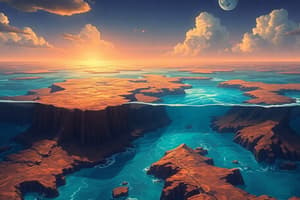Podcast
Questions and Answers
Flashcards
Earth's outer layer
Earth's outer layer
The solid, hard part of Earth's surface.
Continental rock
Continental rock
Hard, solid rock found beneath continents.
Oceanic rock
Oceanic rock
Rock beneath the ocean floor.
Drilling for rock
Drilling for rock
Signup and view all the flashcards
Indian Ocean
Indian Ocean
Signup and view all the flashcards
Sri Lanka
Sri Lanka
Signup and view all the flashcards
Hard rock under continents?
Hard rock under continents?
Signup and view all the flashcards
Hard rock under oceans?
Hard rock under oceans?
Signup and view all the flashcards
Earth's outer layer composition
Earth's outer layer composition
Signup and view all the flashcards
Question 13 Option a
Question 13 Option a
Signup and view all the flashcards
Question 13 Option b
Question 13 Option b
Signup and view all the flashcards
Question 13 Option c
Question 13 Option c
Signup and view all the flashcards
Question 13 Option d
Question 13 Option d
Signup and view all the flashcards
Continental crust
Continental crust
Signup and view all the flashcards
Oceanic crust
Oceanic crust
Signup and view all the flashcards
Composition difference between oceanic and continental crust
Composition difference between oceanic and continental crust
Signup and view all the flashcards
Mineral composition underneath ocean
Mineral composition underneath ocean
Signup and view all the flashcards
Plate Tectonics
Plate Tectonics
Signup and view all the flashcards
Convergent Plate Boundary
Convergent Plate Boundary
Signup and view all the flashcards
Subduction Zone
Subduction Zone
Signup and view all the flashcards
Oceanic-Continental Convergence
Oceanic-Continental Convergence
Signup and view all the flashcards
Diagram A
Diagram A
Signup and view all the flashcards
Diagram B
Diagram B
Signup and view all the flashcards
Diagram C
Diagram C
Signup and view all the flashcards
Diagram D
Diagram D
Signup and view all the flashcards
GPS Data
GPS Data
Signup and view all the flashcards
Plate Movement
Plate Movement
Signup and view all the flashcards
Plate Collision
Plate Collision
Signup and view all the flashcards
Mantle
Mantle
Signup and view all the flashcards
Plate Subduction
Plate Subduction
Signup and view all the flashcards
Convergent Boundary
Convergent Boundary
Signup and view all the flashcards
Divergent Boundary
Divergent Boundary
Signup and view all the flashcards
Transform Boundary
Transform Boundary
Signup and view all the flashcards
Earthquakes
Earthquakes
Signup and view all the flashcards
Volcanoes
Volcanoes
Signup and view all the flashcards
Mountain Formation
Mountain Formation
Signup and view all the flashcards
Seafloor Spreading
Seafloor Spreading
Signup and view all the flashcards
Fault Line
Fault Line
Signup and view all the flashcards
Tectonic Plates
Tectonic Plates
Signup and view all the flashcards
Plate Boundaries
Plate Boundaries
Signup and view all the flashcards
Geological Features
Geological Features
Signup and view all the flashcards
Cynognathus fossils
Cynognathus fossils
Signup and view all the flashcards
How did Cynognathus fossils get so far apart?
How did Cynognathus fossils get so far apart?
Signup and view all the flashcards
What causes the movement of tectonic plates?
What causes the movement of tectonic plates?
Signup and view all the flashcards
What are the consequences of plate movement?
What are the consequences of plate movement?
Signup and view all the flashcards
What is a plate boundary?
What is a plate boundary?
Signup and view all the flashcards
Types of plate boundaries
Types of plate boundaries
Signup and view all the flashcards
Transform plate boundary
Transform plate boundary
Signup and view all the flashcards
Subduction
Subduction
Signup and view all the flashcards
What is a supercontinent?
What is a supercontinent?
Signup and view all the flashcards
Evidence of plate tectonics
Evidence of plate tectonics
Signup and view all the flashcards
How do we know plates are moving?
How do we know plates are moving?
Signup and view all the flashcards
How long does it take for continents to move?
How long does it take for continents to move?
Signup and view all the flashcards
What is a fault line?
What is a fault line?
Signup and view all the flashcards
How do mountains form?
How do mountains form?
Signup and view all the flashcards
Study Notes
Question 13 Analysis
- A team of engineers wants to identify hard, solid rock beneath the surface in the Indian Ocean and Sri Lanka.
- Option A suggests rock exists under both locations, citing the entire Earth's outer layer as hard, solid rock.
- Option B states that only under Sri Lanka (a continent) is there hard rock.
- Option C explains that water is present under both areas, which would inhibit drilling for rock.
- Option D claims the presence of sand and gravel prevents rock discovery.
Studying That Suits You
Use AI to generate personalized quizzes and flashcards to suit your learning preferences.




